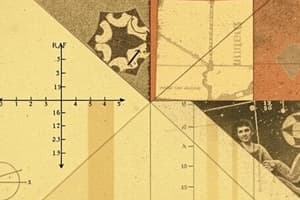Podcast
Questions and Answers
What is the Midpoint Formula?
What is the Midpoint Formula?
- (x,y) + (x+a, y+b)
- Line segment length
- Average of x-coordinates and y-coordinates (correct)
- (x,a) + (y,b)
What is the Distance Formula?
What is the Distance Formula?
- Sum of all sides
- x/y
- Length of the diagonal
- √((x2 - x1)² + (y2 - y1)²) (correct)
What is the Slope Formula?
What is the Slope Formula?
rise/run
A positive slope indicates a line that rises as it moves from left to right.
A positive slope indicates a line that rises as it moves from left to right.
A negative slope indicates a line that rises as it moves from left to right.
A negative slope indicates a line that rises as it moves from left to right.
When are two non-vertical lines parallel?
When are two non-vertical lines parallel?
What condition do lines meet to be classified as perpendicular?
What condition do lines meet to be classified as perpendicular?
What is the Translations Formula?
What is the Translations Formula?
What is the formula for reflections over the x-axis?
What is the formula for reflections over the x-axis?
What is the formula for reflections over the y-axis?
What is the formula for reflections over the y-axis?
What is the formula for rotating a point 90 degrees clockwise?
What is the formula for rotating a point 90 degrees clockwise?
What is the formula for rotating a point 90 degrees counterclockwise?
What is the formula for rotating a point 90 degrees counterclockwise?
What is the formula for rotating a point 180 degrees counterclockwise?
What is the formula for rotating a point 180 degrees counterclockwise?
What is the Dilation Formula?
What is the Dilation Formula?
Dilation reduction results in an increase in size.
Dilation reduction results in an increase in size.
What is Glide Reflection?
What is Glide Reflection?
What do you need to know to classify a square?
What do you need to know to classify a square?
What do you need to know to classify a right triangle?
What do you need to know to classify a right triangle?
What do you need to know to classify a rectangle?
What do you need to know to classify a rectangle?
What do you need to know to classify a rhombus?
What do you need to know to classify a rhombus?
What do you need to know to classify a trapezoid?
What do you need to know to classify a trapezoid?
What do you need to know to classify a parallelogram?
What do you need to know to classify a parallelogram?
What do you need to know to classify a kite?
What do you need to know to classify a kite?
Flashcards are hidden until you start studying
Study Notes
Midpoint and Distance Formulas
- Midpoint Formula: Formula to find the exact center point between two points in a coordinate plane.
- Distance Formula: Used to calculate the distance between two points; derived from the Pythagorean theorem.
Slope Concepts
- Slope Formula: The ratio of the vertical change (rise) to the horizontal change (run) between two points on a line.
- Positive Slope: Indicates that as the x-value increases, the y-value also increases; visually, this produces an upward slant to the right.
- Negative Slope: Indicates that as the x-value increases, the y-value decreases; visually, this results in a downward slant to the right.
Line Relationships
- Slopes of Parallel Lines: Two non-vertical lines in a coordinate plane are parallel if they share the same slope.
- Slopes of Perpendicular Lines: Lines are perpendicular if the product of their slopes equals -1; they possess opposite reciprocal slopes.
Transformations
- Translation Formula: Moves a point (x,y) to a new position by adding a horizontal shift (a) and a vertical shift (b).
- Reflections:
- Over the x-axis: Reflects a point (x,y) to (x,-y).
- Over the y-axis: Reflects a point (x,y) to (-x,y).
- Rotation:
- 90 degrees clockwise: Transforms a point (x,y) to (y,-x).
- 90 degrees counterclockwise: Transforms a point (x,y) to (-y,x).
- 180 degrees counterclockwise: Transforms a point (x,y) to (-x,-y).
- Dilation: Scales a point (x,y) by a factor of k; resulting point is (kx, ky).
Shapes Classification
- Square: All sides equal in length and all angles are 90 degrees (perpendicular).
- Right Triangle: Contains a 90-degree angle formed by two perpendicular sides.
- Rectangle: Opposite sides are both congruent and parallel with four right angles.
- Rhombus: All sides are equal and opposite sides are parallel; angles are not necessarily 90 degrees.
- Trapezoid: Only one pair of sides is parallel, distinguishing it from other quadrilaterals.
- Parallelogram: Opposite sides and angles are congruent; diagonals bisect each other.
- Kite: Features two pairs of adjacent congruent sides, with diagonals that cross at right angles.
Studying That Suits You
Use AI to generate personalized quizzes and flashcards to suit your learning preferences.



